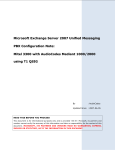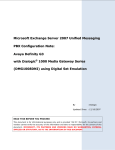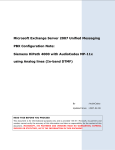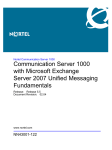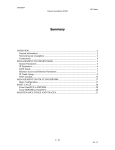Download Alcatel 4400 Configuration Note
Transcript
Microsoft Exchange Server 2007 Unified Messaging
PBX Configuration Note:
Alcatel OmniPCX 4400 with AudioCodes MP-11x
FXO using Analog lines (In-band DTMF)
By
: AudioCodes
Updated Since : 2007-02-09
READ THIS BEFORE YOU PROCEED
This document is for informational purposes only and is provided “AS IS”. Microsoft, its partners and
vendors cannot verify the accuracy of this information and take no responsibility for the content of this
document. MICROSOFT, ITS PARTNERS AND VENDORS MAKE NO WARRANTIES, EXPRESS,
IMPLIED OR STATUTORY, AS TO THE INFORMATION IN THIS DOCUMENT.
1
Content
This document describes the configuration required to setup Alcatel OmniPCX 4400 and AudioCodes
MP-11x FXO using analog lines with inband DTMF as the telephony signaling protocol. It also contains
the results of the interoperability testing of Microsoft Exchange 2007 Unified Messaging based on this
setup.
Intended Audience
This document is intended for Systems Integrators with significant telephony knowledge.
Technical Support
The information contained within this document has been provided by Microsoft, its partners or
equipment manufacturers and is provided AS IS. This document contains information about how to
modify the configuration of your PBX or VoIP gateway. Improper configuration may result in the loss
of service of the PBX or gateway. Microsoft is unable to provide support or assistance with the
configuration or troubleshooting of components described within. Microsoft recommends readers to
engage the service of an Microsoft Exchange 2007 Unified Messaging Specialist or the manufacturers
of the equipment(s) described within to assist with the planning and deployment of Exchange Unified
Messaging.
Microsoft Exchange 2007 Unified Messaging (UM) Specialists
These are Systems Integrators who have attended technical training on Exchange 2007 Unified
Messaging conducted by Microsoft Exchange Engineering Team. For contact information, visit here.
Version Information
Date of Modification
Details of Modification
21 March 2007
Version 1
2
1. Components Information
1.1. PBX or IP-PBX
PBX Vendor
Alacatel
Model
OmniPCX 4400
Software Version
R4.2-d2.304-4-h-il-c6s2
Telephony Signaling
Analog In-band DTMF Tones
Additional Notes
None
1.2. VoIP Gateway
Gateway Vendor
AudioCodes
Model
MP-11x FXO (MP-114 / MP-118)
Software Version
5.0
VoIP Protocol
SIP
1.3. Microsoft Exchange Server 2007 Unified Messaging
Version
RTM
2. Prerequisites
2.1. Gateway Prerequisites
The gateway also supports TLS (in addition to TCP). This provides security by enabling the encryption
of SIP packets over the IP network.
2.2. PBX Prerequisites
The PBX hardware must be installed with an Analog Line Interface Card (Z12, Z24, Z32).
2.3. Cabling Requirements
This integration uses standard RJ-11 telephone line cords.
3
3. Summary and Limitations
A check in this box indicates the UM feature set is fully functional when using the PBX/gateway
in question.
Alcatel OmniPCX 4400 PBX has several limitations when activating the voice mail functionality. The list
below describes these PBX’s limitations:
•
The PBX doesn’t support the sending of the calling user number for direct calls (i.e., user calls
UM to retrieve voice message). Therefore, when the user dials directly to the Microsoft Unified
Messaging, the user hears the general welcome prompt: “Welcome, you are connected to
Microsoft Exchange, to access your mailbox, enter your extension.”, at which the user is
required to enter the user's extension number in addition to the pin number.
•
When performing blind transfer to an invalid number, the PBX doesn’t support invalid number
notification and the call is routed back to the original transfer user. When an invalid extension
number is defined in the Microsoft Unified Messaging for a particular user, and call transfer by
Directory Search to this user is requested, the user that requests this transfer is routed back
to the Microsoft Unified Messaging welcome prompt.
4
4. Gateway Setup Notes
Step 1: SIP Environment Setup
5
Step 2: Routing Setup
Note: The Proxy IP Address must be one that corresponds to the network environment in which the
Microsoft Unified Messaging server is installed (For example, 172.20.22.211 or the FQDN of the
Microsoft Unified Messaging host).
6
Step 3: SIP Environment Setup (Cont.)
7
Step 4: Coder Setup
8
Step 5: Digit Collection Setup
9
Step 6: Message Waiting Indication Setup
10
Step 7: Manipulation Setup
11
Step 8: Endpoints Setup
Note: The phone numbers must correspond to your network environment as the dial plan pilot
number is configured for this PBX in the Microsoft Unified Messaging server (For example, 11111).
12
Step 9: Hot Line Setup
13
Step 10: Voice mail In-Band DTMF Setup
There are two options to setup the voice mail In-Band DTMF:
•
If the current Alacatel OnmiPCX 4400 software package supports Caller ID for voice mail
extensions (CLIP on VPS SL), follow Step 10 (a).
•
If the current Alacatel OnmiPCX 4400 software package does not support Caller ID for voice mail
extensions (CLIP on VPS SL), follow Step 10 (b).
To verify whether or not your PBX supports this package, check steps 18 through 21 in
Chapter 7.
Step 10 (a): Voice mail In-Band DTMF Setup (PBX software package supports CLIP on VPS SL)
14
Step 10 (b): Voice mail In-Band DTMF Setup (PBX software package does not support CLIP on VPS
SL)
15
Step 11: FAX Setup
16
Step 12: FXO General Setup
17
Step 13: FXO General Setup (Cont.)
18
Step 14: FXO General Setup (Cont.)
Step 15: FXO General Setup (Cont.)
CallProgressTonesFilename = 'CPT alcatel_omnipcx.dat'
EnableDetectRemoteMACChange = 2
ECNLPMode = 1
19
Step 16: Reset FXO
Note: Steps 1 and 7 involve core configuration changes (versus default settings):
•
Proxy IP Address (Microsoft Unified Messaging IP address)
•
Enabling Message Waiting process
These changes require a gateway reset (by default, when performing a gateway reset, the
configuration is burnt to flash memory). If no change is made to these two core configuration
parameters, skip to Step 17.
20
Step 17: Save Gateway Configuration
Note: This step is optional and is note required if you performed Step 16.
21
4.1. Configuration Files
The ZIP file includes the following files:
•
Audiocodes configuration ini file for PBXs that support Caller ID for voice mail extensions (INI
Alcatel OmniPCX4400 FXO DTMF - PBX Caller id enabled.ini).
•
Audiocodes configuration ini file for PBXs that do not support Caller ID for voice mail extensions
(INI Alcatel OmniPCX4400 FXO DTMF - PBX Caller id disabled.ini).
•
Audiocodes Call Progress Tones file for Alcatel OmniPCX 4400 PBX (.dat file extension).
Alcatel OmniPCX4400
FXO DTMF
22
4.2. TLS Setup
Step 1: PBX to IP Routing Setup
Note: The Proxy IP Address and Name must be one that corresponds to the network environment in
which the Microsoft Unified Messaging server is installed (For example, 10.15.3.207 for IP Address and
exchaneg2007.com for the FQDN of the Microsoft Unified Messaging host).
23
Step 2: SIP Environment and Gateway Name Setup
Note: Assign an FQDN name to the gateway (for example, gw2.fxoaudiocodes.com). Any gateway
name that corresponds to your network environment is applicable; the only limitation is not to include
underscores in the name (Windows Certification server limitation).
24
Step 3: SIP Environment Setup (Cont.)
25
Step 4: DNS Servers Setup
Note: Define the primary and secondary DNS servers' IP addresses so that they correspond to your
network environment (for example, 10.1.1.11 and 10.1.1.10). If no DNS server is available in the
network, then skip this step.
26
Step 5: Internal DNS Setup
Note: If no DNS server is available in the network, define the internal DNS table where the domain
name is the FQDN of the Microsoft Unified Messaging server and the First IP Address corresponds to
its IP address (for example, exchange2007.com and 10.15.3.207).
27
Step 6: NTP Server Setup
Note: Define the NTP server’s IP address so that it corresponds to your network environment (for
example, 10.15.3.50). If no NTP server is available in the network, then skip this step (as the gateway
uses it’s internal clock).
28
Step 7: Generate Certificate Setup
Use the screen below to generate CSR. Copy the certificate signing request and send it to your
Certification Authority for signing.
29
Step 8: Uploading Certificates Setup
The screen below is used to upload the sign certificates.
In the “Server Certificate” area, upload the gateway certificate signed by the CA.
In the “Trusted Root Certificate Store” area, upload the CA certificate.
30
5. PBX Setup Notes
Configuring Voice Mail extensions
Step 1: Select the Users object.
31
Step 2: Right-click the Users object, and then from the shortcut menu, choose Create.
32
Step 3: The Create window opens.
33
Step 4: In the Create window, fill in the following fields:
•
Directory Number: Free extension number in the PBX, for example, 541,542.
•
Directory Name: Unique name for this group in the PBX, for example, VPS.
•
Shelf Address, Board Address, and Equipment Address: Fill in the physical location of the
extension in the PBX.
•
Set Type: must be 4620 (VPS + CLIP).
Step 5: Click the Create/Modify button.
Step 6: Repeat steps 2 through 5 for as many Voice-Mail access extension that are needed.
34
Step 7: After you have finished creating all the required Voice-Mail access extensions, double-click the
Users object. The full users/extensions list of the PBX appears. Scroll down the list until you see the
users that you defined.
35
Step 8: In the main menu, double-click the Groups object. A list of the available groups in the PBX
are shown.
36
Step 9: Right-click the Hunt Group object, and then from the shortcut menu, choose Create.
37
Step 10: In the opened Create window, enter the following:
•
Directory Number: Unique hunt group number in the PBX, for example, 540.
•
Directory Name: Unique hunt group name in the PBX, for example, VPS.
Verify that the Type of Hunt Group is PBX Hunt Group.
Step
11:
When
you
have
completed
defining
the
Hunt
Group,
click
Create/Modify.
38
Step 12: Click the Users object. The full users/extensions list of the PBX appears. Scroll down the list
until you see the users that you defined. Access each of the users by right-clicking the user, and then
from the shortcut menu, choosing Edit.
39
Step 13: In the Edit window, scroll down until the Hunt Group Dir No. field is visible. In this field,
enter the Directory Number of the hunt group that you defined in Step 10, for example, 540. Click OK
to apply the settings. Repeat this step for each voice mail user you defined in steps 2 through 5.
40
Configuring Message Waiting Indication
Step 14: In the main menu, double-click the Translator object.
41
Step 15: Double-click the Prefix Plan object. A list of all the feature access codes appears.
42
Step 16: Verify the feature access code (Number) for the Local Feature of the type Message Deposit.
Perform this by right-clicking each feature in the list, and then from the shortcut menu, choosing Edit.
For
example,
the
feature
access
code
number
is
136
(as
shown
below).
43
Step 17: In the same list of feature access codes, verify the feature access code (Number) for the
Local Feature of the type Switch off Message LED. Perform this by right-clicking each feature in the
list, and then from the shortcut menu, choosing Edit. For example, the feature access code number is
137 (as shown below).
44
Verify whether or not the PBX supports Caller ID for Voice Mail extensions
Step 18: In the main menu, double-click the System object. A list of the available system parameters
in the PBX is shown.
45
Step 19: Scroll down the list until you see the Software Package object. Double-click the Software
Package object. A list of all software packages appears.
46
Step 20: Scroll down the list until you see the CLIP on VPS SL object. To verify the availability of
Caller ID for the voice mail extensions, right-click the object, and then from the shortcut menu,
choose Edit.
47
Step 21: In the Edit window, verify the value in the Authorized Limit field. This value displays the
total amount of voice mail extensions that are authorized to have the Caller ID feature. If the value of
this field is zero (0), the PBX's software package does not support Caller ID for the voice mail
extension.
48
5.1. TLS Setup
•
N/A.
5.2. Fail-Over Configuration
•
N/A.
5.3. Tested Phones
Alcatel Advanced Reflexes.
5.4. Other Comments
None.
49
6. Exchange 2007 UM Validation Test Matrix
The following table contains a set of tests for assessing the functionality of the UM core feature set.
The results are recorded as either:
•
Pass (P)
•
Conditional Pass (CP)
•
Fail (F)
•
Not Tested (NT)
•
Not Applicable (NA)
Refer to:
•
Appendix for a more detailed description of how to perform each call scenario.
•
Section 6.1 for detailed descriptions of call scenario failures, if any.
No.
Call Scenarios (see appendix for more
detailed instructions)
(P/CP/F/NT)
1
Dial the pilot number from a phone
extension that is NOT enabled for Unified
Messaging and logon to a user’s mailbox.
P
Reason for Failure (see 6.1
detailed descriptions)
for
more
Confirm hearing the prompt: “Welcome,
you are connected to Microsoft Exchange.
To access your mailbox, enter your
extension…”
2
Navigate mailbox using the Voice User
Interface (VUI).
P
3
Navigate mailbox using the Telephony
User Interface (TUI).
P
4
Dial user extension and leave a voicemail.
4a
Dial user extension and leave a voicemail
from an internal extension.
P
Confirm the Active Directory name of the
calling party is displayed in the sender
field of the voicemail message.
4b
Dial user extension and leave a voicemail
from an external phone.
P
Confirm the correct phone number of the
calling party is displayed in the sender
field of the voicemail message.
5
Dial Auto Attendant (AA).
P
50
Dial the extension for the AA and confirm
the AA answers the call.
6
Call Transfer by Directory Search.
6a
Call Transfer by Directory Search and
have the called party answer.
P
Confirm the correct called party answers
the phone.
6b
Call Transfer by Directory Search when
the called party’s phone is busy.
P
Confirm the call is routed to the called
party’s voicemail.
6c
Call Transfer by Directory Search when
the called party does not answer.
P
Confirm the call is routed to the called
party’s voicemail.
6d
Setup an invalid extension number for a
particular user. Call Transfer by Directory
Search to this user.
CP
The Alcatel OmniPCX doesn’t support invalid
number notification and the call is routed back
to the Microsoft Unified Messaging welcome
prompt.
Confirm the number is reported as invalid.
7
Outlook Web Access
Phone Feature.
(OWA)
Play-On-
7a
Listen to voicemail using OWA’s Play-OnPhone feature to a user’s extension.
P
7b
Listen to voicemail using OWA’s Play-OnPhone feature to an external number.
P
8
Configure a button on the phone of a UMenabled user to forward the user to the
pilot number. Press the voicemail button.
CP
Due to PBX limitation, the user is requested to
not only enter the pin number, but also the
extension number.
Confirm you are sent to the prompt:
“Welcome, you are connected to Microsoft
Exchange. <User>. Please enter your pin
and press the pound key.”
9
Send a test
extension.
FAX
message
to
user
P
51
Confirm the FAX is received in the user’s
inbox.
10
Setup TLS between gateway/IP-PBX and
Exchange UM.
Windows Certificate Authority (CA).
10a
Dial the pilot number and logon to a
user’s mailbox.
P
Confirm UM answers the call and confirm
UM responds to DTMF input.
10b
Dial a user
voicemail.
extension
and
leave
a
P
user
P
Confirm the user receives the voicemail.
10c
Send a test
extension.
FAX
message
to
Confirm the FAX is received in the user’s
inbox.
11
Setup G.723.1 on the gateway. (If
already using G.723.1, setup G.711 A Law
or G.711 Mu Law for this step).
P
Dial the pilot number and confirm the UM
system answers the call.
12
Setup Message Waiting Indicator (MWI).
P
Geomant offers a third party solution:
MWI 2007. Installation files and product
documentation
can
be
found
on
Geomant’s MWI 2007 website.
13
Execute Test-UMConnectivity.
NT
14
Setup and test fail-over configuration on
the IP-PBX to work with two UM servers.
NA
52
6.1. Detailed Description of Limitations
Failure Point
The Alcatel OmniPCX 4400 PBX doesn’t send the
calling extension number for direct calls.
Phone type (if phone-specific)
All types
Call scenarios(s) associated with failure point
8
List of UM features affected by failure point
The user is requested to not only enter the pin
number, but also the extension number.
Additional Comments
The PBX doesn’t support the sending of the calling user number for direct calls (i.e., user calls UM to
retrieve voice message). Therefore, when the user dials directly to the Microsoft Unified Messaging,
the user hears the general welcome prompt: “Welcome, you are connected to Microsoft Exchange, to
access your mailbox, enter your extension.”, at which the user is required to enter the user's
extension number in addition to the pin number.
Failure Point
The Alcatel OmniPCX 4400 PBX doesn’t support
invalid number notification.
Phone type (if phone-specific)
All types
Call scenarios(s) associated with failure point
6d
List of UM features affected by failure point
Transfer to a Microsoft Unified Messaging server
user's voicemail after transfer to an invalid
number of the user.
Additional Comments
When performing blind transfer to an invalid number, the PBX doesn’t support invalid number
notification and the call is routed back to the original transfer user. When an invalid extension number
that's defined in the Microsoft Unified Messaging for a particular user, and a call transfer by Directory
Search to this user is requested, the user that requests this transfer is routed back to the Microsoft
Unified Messaging welcome prompt.
53
7. Troubleshooting
The tools used for debugging include network sniffer applications (such as Ethereal) and AudioCodes'
Syslog protocol.
The Syslog client, embedded in the AudioCodes gateways (MP-11x, Mediant 1000, and Mediant 2000),
sends error reports/events generated by the gateway application to a Syslog server, using IP/UDP
protocol.
To activate the Syslog client on the AudioCodes gateways:
1.
Set the parameter Enable Syslog to 'Enable'.
2.
Use the parameter Syslog Server IP Address to define the IP address of the Syslog server you
use.
Step 2
Step 1
Note: The Syslog Server IP address must be one that corresponds to your network environment
in which the Syslog server is installed (for example, 10.15.2.5).
54
3.
To determine the Syslog logging level, use the parameter Debug Level and set this parameter to
'5'.
4.
Change the CDR Report Level to 'End Call' to enable additional call information.
Step 4
Step 3
AudioCodes has also developed advanced diagnostic tools that may be used for high-level
troubleshooting. These tools include the following:
•
Call Progress Tone wizard (CPTWizard): helps detect the Call Progress Tones generated by the
PBX. The software automatically creates a basic Call Progress Tones file.
•
DSP Recording: DSP recording is a procedure used to monitor the DSP operation (e.g., rtp
packets and events).
55
Appendix
1. Dial Pilot Number and Mailbox Login
•
Dial the pilot number of the UM server from an extension that is NOT enabled for UM.
•
Confirm hearing the greeting prompt: “Welcome, you are connected to Microsoft Exchange. To
access your mailbox, enter your extension...”
•
Enter the extension, followed by the mailbox PIN of an UM-enabled user.
•
Confirm successful logon to the user’s mailbox.
2. Navigate Mailbox using Voice User Interface (VUI)
•
Logon to a user’s UM mailbox.
•
If the user preference has been set to DTMF tones, activate the Voice User Interface (VUI)
under personal options.
•
Navigate through the mailbox and try out various voice commands to confirm that the VUI is
working properly.
•
This test confirms that the RTP is flowing in both directions and speech recognition is working
properly.
3. Navigate Mailbox using Telephony User Interface (TUI)
•
Logon to a user’s UM mailbox.
•
If the user preference has been set to voice, press “#0” to activate the Telephony User
Interface (TUI).
•
Navigate through the mailbox and try out the various key commands to confirm that the TUI is
working properly.
•
This test confirms that both the voice RTP and DTMF RTP (RFC 2833) are flowing in both
directions.
4. Dial User Extension and Leave Voicemail
•
Note: If you are having difficulty reaching the user’s UM voicemail, verify that the coverage
path for the UM-enabled user’s phone is set to the pilot number of the UM server.
a. From an Internal Extension
a.
From an internal extension, dial the extension for a UM-enabled user and leave a
voicemail message.
b.
Confirm the voicemail message arrives in the called user’s inbox.
c.
Confirm this message displays a valid Active Directory name as the sender of this
voicemail.
56
b. From an External Phone
a.
From an external phone, dial the extension for a UM-enabled user and leave a
voicemail message.
b.
Confirm the voicemail message arrives in the called user’s inbox.
c.
Confirm this message displays the phone number as the sender of this voicemail.
5. Dial Auto Attendant(AA)
•
Create an Auto Attendant using the Exchange Management Console:
a.
Under the Exchange Management Console, expand “Organizational Configuration” and
then click on “Unified Messaging”.
b.
Go to the Auto Attendant tab under the results pane.
c.
Click on the “New Auto Attendant…” under the action pane to invoke the AA wizard.
d.
Associate the AA with the appropriate dial plan and assign an extension for the AA.
e.
Create PBX dialing rules to always forward calls for the AA extension to the UM server.
f.
Confirm the AA extension is displayed in the diversion information of the SIP Invite.
•
Dial the extension of Auto Attendant.
•
Confirm the AA answers the call.
6. Call Transfer by Directory Search
•
Method one: Pilot Number Access
•
Dial the pilot number for the UM server from a phone that is NOT enabled for UM.
•
To search for a user by name:
•
Press # to be transferred to name Directory Search.
•
•
•
Call Transfer by Directory Search by entering the name of a user in the same
Dial Plan using the telephone keypad, last name first.
To search for a user by email alias:
•
Press “#” to be transferred to name Directory Search
•
Press “# #” to be transferred to email alias Directory Search
•
Call Transfer by Directory Search by entering the email alias of a user in the
same Dial Plan using the telephone keypad, last name first.
Method two: Auto Attendant
•
Follow the instructions in appendix section 5 to setup the AA.
•
Call Transfer by Directory Search by speaking the name of a user in the same Dial
Plan. If the AA is not speech enabled, type in the name using the telephone keypad.
57
•
Note: Even though some keys are associated with three or four numbers, for each letter, each
key only needs to be pressed once regardless of the letter you want. Ignore spaces and
symbols when spelling the name or email alias.
a. Called Party Answers
•
Call Transfer by Directory Search to a user in the same dial plan and have the called party
answer.
•
Confirm the call is transferred successfully.
b. Called Party is Busy
•
Call Transfer by Directory Search to a user in the same dial plan when the called party is busy.
•
Confirm the calling user is routed to the correct voicemail.
c. Called Party does not Answer
•
Call Transfer by Directory Search to a user in the same dial plan and have the called party not
answer the call.
•
Confirm the calling user is routed to the correct voicemail.
d. The Extension is Invalid
•
Assign an invalid extension to a user in the same dial plan. An invalid extension has the same
number of digits as the user’s dial plan and has not been mapped on the PBX to any user or
device.
a.
UM Enable a user by invoking the “Enable-UMMailbox” wizard.
b.
Assign an unused extension to the user.
c.
Do not map the extension on the PBX to any user or device.
d.
Call Transfer by Directory Search to this user.
e.
Confirm the call fails and the caller is prompted with appropriate messages.
7. Play-On-Phone
•
To access play-on-phone:
a.
Logon to Outlook Web Access (OWA) by going to URL https://<server name>/owa.
b.
After receiving a voicemail in the OWA inbox, open this voicemail message.
c.
At the top of this message, look for the Play-On-Phone field (
d.
Click this field to access the Play-On-Phone feature.
Play on Phone...).
a. To an Internal Extension
•
Dial the extension for a UM-enabled user and leave a voicemail message.
•
Logon to this called user’s mailbox in OWA.
58
•
Once it is received in the user’s inbox, use OWA’s Play-On-Phone to dial an internal extension.
•
Confirm the voicemail is delivered to the correct internal extension.
b. To an External Phone number
•
Dial the extension for a UM-enabled user and leave a voicemail message.
•
Logon to the UM-enabled user’s mailbox in OWA.
•
Confirm the voicemail is received in the user’s mailbox.
•
Use OWA’s Play-On-Phone to dial an external phone number.
•
Confirm the voicemail is delivered to the correct external phone number.
•
Troubleshooting:
a.
Make sure the appropriate UMMailboxPolicy dialing rule is configured to make this call.
As an example, open an Exchange Management Shell and type in the following
commands:
b.
$dp = get-umdialplan -id <dial plan ID>
c.
$dp.ConfiguredInCountryOrRegionGroups.Clear()
d.
$dp.ConfiguredInCountryOrRegionGroups.Add("anywhere,*,*,")
e.
$dp.AllowedInCountryOrRegionGroups.Clear()
f.
$dp.AllowedInCountryOrRegionGroups.Add(“anywhere")
g.
$dp|set-umdialplan
h.
$mp = get-ummailboxpolicy -id <mailbox policy ID>
i.
$mp.AllowedInCountryGroups.Clear()
j.
$mp.AllowedInCountryGroups.Add("anywhere")
k.
$mp|set-ummailboxpolicy
l.
The user must be enabled for external dialing on the PBX.
m. Depending on how the PBX is configured, you may need to prepend the trunk access
code (e.g. 9) to the external phone number.
8. Voicemail Button
•
Configure a button on the phone of a UM-enabled user to route the user to the pilot number of
the UM server.
•
Press this voicemail button on the phone of an UM-enabled user.
•
Confirm you are sent to the prompt: “Welcome, you are connected to Microsoft Exchange.
<User Name>. Please enter your pin and press the pound key.”
•
Note: If you are not hearing this prompt, verify that the button configured on the phone
passes the user’s extension as the redirect number. This means that the user extension should
appear in the diversion information of the SIP invite.
59
9. FAX
•
Use the Management Console or the Management Shell to FAX-enable a user.
•
Management Console:
•
a.
Double click on a user’s mailbox and go to Mailbox Features tab.
b.
Click Unified Messaging and then click the properties button.
c.
Check the box “Allow faxes to be received”.
Management Shell - execute the following command:
a.
•
Set-UMMailbox –identity UMUser –FaxEnabled:$true
To test fax functionality:
a.
Dial the extension for this fax-enabled UM user from a fax machine.
b.
Confirm the fax message is received in the user’s inbox.
c.
Note: You may notice that the UM server answers the call as though it is a voice call
(i.e. you will hear: “Please leave a message for…”). When the UM server detects the
fax CNG tones, it switches into fax receiving mode, and the voice prompts terminate.
d.
Note: UM only support T.38 for sending fax.
10.TRANSPORT SECURITY LAYER (TLS)
•
Setup TLS on the gateway/IP-PBX and Exchange 2007 UM.
•
Import/Export all the appropriate certificates.
a. Dial Pilot Number and Mailbox Login
•
Execute the steps in scenario 1 (above) with TLS turned on.
b. Dial User Extension and Leave a Voicemail
•
Execute the steps in scenario 4 (above) with TLS turned on.
c. FAX
•
Execute the steps in scenario 9 (above) with TLS turned on.
11.G.723.1
•
Configure the gateway to use the G.723.1 codec for sending audio to the UM server.
•
If already using G.723.1 for the previous set of tests, use this step to test G.711 A Law or
G.711 Mu Law instead.
•
Call the pilot number and verify the UM server answers the call.
•
Note: If the gateway is configured to use multiple codecs, the UM server, by default, will use
the G.723.1 codec if it is available.
60
12.Message Waiting Indicator (MWI)
•
Although Exchange 2007 UM does not natively support MWI, Geomant has created a 3rd party
solution - MWI2007. This product also supports SMS message notification.
•
Installation files and product documentation can be found on Geomant’s MWI 2007 website.
13.Test-UMConnectivity
•
Run the Test-UMConnectivity diagnostic cmdlet by executing the following command in
Exchange Management Shell:
•
Test-UMConnectivity –UMIPGateway:<Gateway> -Phone:<Phone> |fl
•
<Gateway> is the name (or IP address) of the gateway which is connected to UM, and
through which you want to check the connectivity to the UM server. Make sure the gateway is
configured to route calls to UM.
•
<Phone> is a valid UM extension. First, try using the UM pilot number for the hunt-group
linked to the gateway. Next, try using a CFNA number configured for the gateway. Please
ensure that a user or an AA is present on the UM server with that number.
•
The output shows the latency and reports if it was successful or there were any errors.
14.Test Fail-Over Configuration on IP-PBX with Two UM Servers
•
This is only required for direct SIP integration with IP-PBX. If the IP-PBX supports fail-over
configuration (e.g., round-robin calls between two or more UM servers):
a.
Provide the configuration steps in Section 5.
b.
Configure the IP-PBX to work with two UM servers.
c.
Simulate a failure in one UM server.
d.
Confirm the IP-PBX transfers new calls to the other UM server successfully.
61






























































